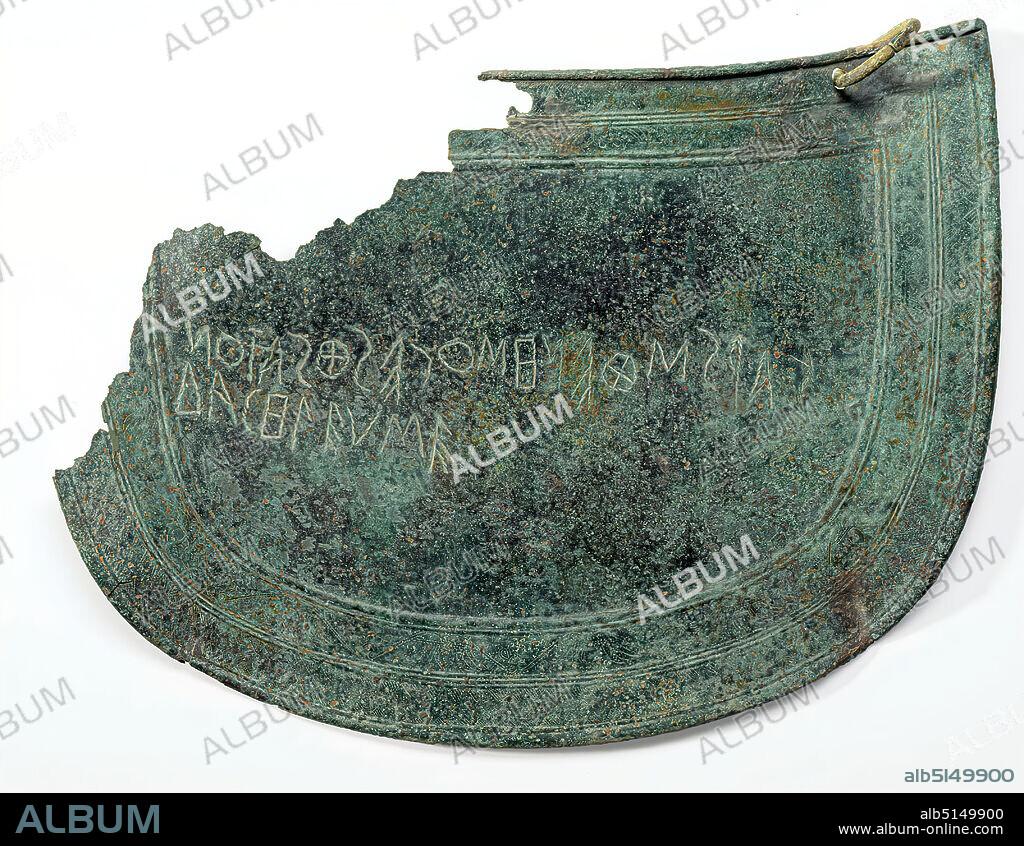alb5149900
Mitre with inscription, bronze, chased, engraved, punched, bronze, total: height: 17 cm; width: 23 cm, inscription: Front: | , protective clothing, armor (warfare/military), weapons (warfare/military), ritual objects and accessories, votive offerings, burial objects, ornaments, lotus ornament, early archaic, Greek antiquity, The mitre is an arch-shaped protective plate for the abdomen, whose convex forged rounding corresponds to the shape of the human abdomen. They seem to be a Cretan peculiarity. Suspended from rings, miters were probably attached to a belt worn under the protruding edge of the bell armour. The edges of miters are usually rolled around a reinforcing wire like the breast and back armour. On some, a figurative representation occupies the entire segment surrounded by the parallel bars. Here, however, there is a two-line inscription in the center. This is one of the oldest Greek inscriptions known. In Boustrophedon ('how the ox ploughs') the following text is engraved in the opposite direction: 'Karisthenes, the son of Peithias carried him away'. The two flat edge strips formed by the border strips contain finely carved and punched ornaments: a lotus palmette tendril and a row of teeth.

|
Add to another lightbox |
|
Add to another lightbox |



Caption:
Mitre with inscription, bronze, chased, engraved, punched, bronze, total: height: 17 cm; width: 23 cm, inscription: Front: | , protective clothing, armor (warfare/military), weapons (warfare/military), ritual objects and accessories, votive offerings, burial objects, ornaments, lotus ornament, early archaic, Greek antiquity, The mitre is an arch-shaped protective plate for the abdomen, whose convex forged rounding corresponds to the shape of the human abdomen. They seem to be a Cretan peculiarity. Suspended from rings, miters were probably attached to a belt worn under the protruding edge of the bell armour. The edges of miters are usually rolled around a reinforcing wire like the breast and back armour. On some, a figurative representation occupies the entire segment surrounded by the parallel bars. Here, however, there is a two-line inscription in the center. This is one of the oldest Greek inscriptions known. In Boustrophedon ('how the ox ploughs') the following text is engraved in the opposite direction: 'Karisthenes, the son of Peithias carried him away'. The two flat edge strips formed by the border strips contain finely carved and punched ornaments: a lotus palmette tendril and a row of teeth.
Credit:
Album / quintlox
Releases:
Model: No - Property: No
Rights questions?
Rights questions?
Image size:
4320 x 3344 px | 41.3 MB
Print size:
36.6 x 28.3 cm | 14.4 x 11.1 in (300 dpi)
Keywords:
'KARISTHENES • ABDOMEN • ACCESSORY • ARCH-SHAPED PROTECTIVE PLATE • ARMOR • ARMS • ARTFORM: BRONZEWORK • ATTACHED • AWAY' • BACK ARMOUR • BELL ARMOUR • BELLY • BELT WORN UNDER • BORDER STRIPS CONTAIN FINELY CARVED • BOUSTROPHEDON • BREAST • BREASTS • BRONCE • BRONZE BRASS • BRONZE • BRONZES • BURIAL OBJECTS • CENTER • CHASED • CHEST • COG • CONVEX FORGED ROUNDING CORRESPONDS • CRETAN PECULIARITY • DECOR • DECORATION • DECORATIONS • DECORATIVE • DENTITION • DENTURE • EARLY ARCHAIC • EDGES • ENGRAVED • ENTIRE SEGMENT SURROUNDED • FIGURATIVE REPRESENTATION OCCUPIES • FOLLOWING TEXT • FORMS (GEOMETRIC) • FRONT • FRONTAL • GREEK ANTIQUITY • HUMAN ABDOMEN • HUNDRED YEARS WAR • INSCRIPTION • LOTUS ORNAMENT • LOTUS PALMETTE TENDRIL • MILITARY • MITERS • MITRE • OLDEST GREEK INSCRIPTIONS • OPPOSITE DIRECTION • ORNAMENT • ORNAMENTATION • ORNAMENTS • OX PLOUGHS' • PARALLEL BARS • PEITHIAS CARRIED • PRONG • PROTECTIVE CLOTHING • PROTRUDING EDGE • PUNCHED ORNAMENTS • PUNCHED • QUARREL • REINFORCING WIRE • RINGS • RITUAL OBJECTS • ROW • ROWS • SET OF TEETH • SHAPE • SON • STOMACH • SUSPENDED • TEETH • TOOTH • TWO FLAT EDGE STRIPS FORMED • TWO-LINE INSCRIPTION • USUALLY ROLLED • VOTIVE OFFERINGS • WAR • WARFARE • WARS • WEAPON • WEAPONRY • WEAPONS
 Pinterest
Pinterest Twitter
Twitter Facebook
Facebook Copy link
Copy link Email
Email

